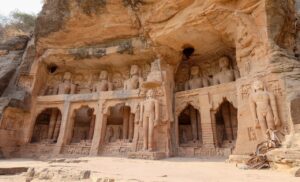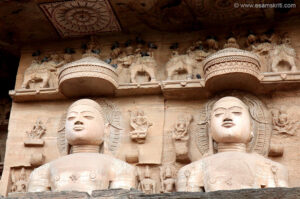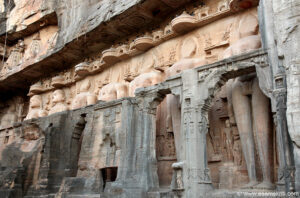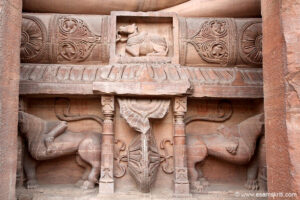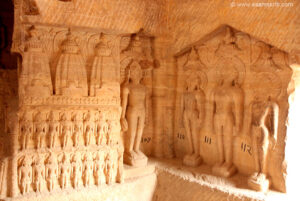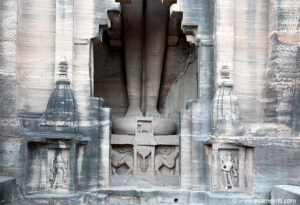The ancient capital of Gwalior is steeped in the splendor of its past. A multitude of reigning dynasties of the great clans of the Pratiharas, Kachwahas, Tomars, Marathas, Moguls, English and the recent Scindia’s, have left indelible etchings of their rule in this city of palaces, temples and monuments. The Gwalior Fort is believed to be one of the largest structures of its kind in the world. One of the most invincible forts in the history of India, this imposing structure inspired Emperor Babar to describe it as, “the Pearl amongst the Fortresses of Hind.” Over 1200 years old, Gwalior Fort is situated on a hill 350 feet above the city, its outer wall is 8 km. long and 45 feet high.
The fort of Gwalior has a numerous exquisite Jain sculptures, some are rock cut and facing narrow ledges in the vertical walls of the solid rock and others are standing. A steep road winds upwards through the hill to the fort. Hundreds of Jaina statues are cut deep into the rock on both sides of the road and towering over it and along the perimeter of the hillsides. Some of them are two to four storeys high and in some cases carved more than 2 mtr. into the rock surface. The Mogul Emperor Babar mutilated most of the images of the Jinas. Several groups of Jina statues have been excavated from the cliff below the walls of the fort. The entire area of Gwalior fort is divided into five groups namely Urvahi, North West, North East, South West and the South East areas. We can find 24 idols in the padmasana posture, 40 in kayotsarga posture and 840 idols are carved on the walls and pillars in the Urvahi area. The prominent statues are those of Lord Adinath, the first Jain Thirthankara, known by the symbol of a bull, Neminath, the 22nd Tirthankara signified by a shell, and Siddhartha and Trishla, Lord Mahavir’s parents. All the statues were carved during the reigns of the Tomar rulers. The largest of all the sculptures is the 58 feet high colossus idol of Bhagwan Adinatha outside the Urvahi gate and the 35 feet high idol of Bhagwan Suparshwanath in the padmasan in Patthar-ki bawdi.
The rock sculptures of Gwalior are magnificent and famous for their large numbers, sheer size and attention to detail in creating the accompanying sculptures of followers, attendants, yakshas, animals, and canopies in the true prescribed form of Jaina iconography. The rocks have been cut in such a way that, first, a room with doors and balconies, is carved. At the far end of the room, the sculptures are chiseled. These cover a 150 feet long area. Each of these caves is divided into four caves, which are further subdivided into cells. Some of the figures are sculpted in such a way that only their feet are visible through the door while the waist area is hidden behind the space between the doors and the balcony. The seated figures are in the second floor of the rooms. There are doors with beautiful corbels and bracket arches. Outside the bracket, an outer and circular arch, composed of floral work, has been carved. Above the Tirthankars, there are richly ornamented canopies of elephants pouring water through their trunks, and lotus flowers.
Gwalior is situated at a distance of 400 km. from Delhi, 118 km. from Agra, and easily accessible by road and rail.


